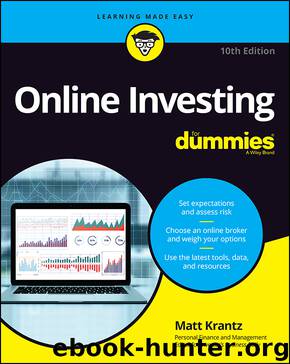Online Investing For Dummies by Matthew Krantz

Author:Matthew Krantz
Language: eng
Format: epub
ISBN: 9781119601500
Publisher: Wiley
Published: 2019-09-11T00:00:00+00:00
Calculating How Risky Your Portfolio Is
The returns you get from investing online are only half of what you need to know. Just as important, if not more so, is how much risk you took on to get those returns. Measuring risk is a little more controversial. You find many ways to do it, and investors generally disagree on the best way.
Most investment professionals, though, acknowledge the value of measuring an investment’s or portfolio’s risk by studying the volatility, or standard deviation, of its returns. Yikes, that term is scary and might conjure up memories of statistics class. But by using readily available online tools, you can use standard deviation as a way to get a handle on how much risk you’re accepting in investing. Standard deviation is a mathematical way to determine how much your portfolio swings in value from its average return.
Just know this: When your portfolio’s standard deviation is a large number, you’ll probably see some big ups and downs in your portfolio’s value. And when the standard deviation is low, you have a good idea that your portfolio won’t keep you up at night.
Statistics tell us that 68 percent of the time, your portfolio should not rise by more than its average return (plus the standard deviation) or fall more than its average return (minus the standard deviation). And 95 percent of the time, your portfolio shouldn’t rise by more than its average return plus two times its standard deviation or fall by more than its average return minus two times its standard deviation.
For example, if you put your money in a five-year certificate of deposit that pays 5 percent interest, the standard deviation of your return would be 0. In other words, you will get 5 percent a year no matter what. But if you invest in a risky stock that returns 15 percent a year on average, your standard deviation might be closer to 40. That means 68 percent of the time you can expect your portfolio to return somewhere between a gain of 55 percent (the 15 percent average return plus the standard deviation) and a loss of 25 percent (the 15 percent average return minus the standard deviation).
Download
This site does not store any files on its server. We only index and link to content provided by other sites. Please contact the content providers to delete copyright contents if any and email us, we'll remove relevant links or contents immediately.
| Analysis & Strategy | Bonds |
| Commodities | Derivatives |
| Futures | Introduction |
| Mutual Funds | Online Trading |
| Options | Portfolio Management |
| Real Estate | Stocks |
Rich Dad Poor Dad by Robert T. Kiyosaki(6414)
Pioneering Portfolio Management by David F. Swensen(6230)
How To Win Friends and Influence People by Dale Carnegie(4447)
The Money Culture by Michael Lewis(4083)
The Dhandho Investor by Mohnish Pabrai(3706)
The Wisdom of Finance by Mihir Desai(3659)
Liar's Poker by Michael Lewis(3372)
Fooled by Randomness: The Hidden Role of Chance in Life and in the Markets by Nassim Nicholas Taleb(3050)
The ONE Thing by Gary Keller(3015)
The Intelligent Investor by Benjamin Graham Jason Zweig(2996)
Mastering Bitcoin: Programming the Open Blockchain by Andreas M. Antonopoulos(2983)
Rich Dad Poor Dad: What The Rich Teach Their Kids About Money - That The Poor And Middle Class Do Not! by Robert T. Kiyosaki(2910)
How to Day Trade for a Living: Tools, Tactics, Money Management, Discipline and Trading Psychology by Andrew Aziz(2909)
Investing For Dummies by Eric Tyson(2895)
How to Win Friends and Influence People by Dale Carnegie(2865)
Market Wizards by Jack D. Schwager(2645)
The Psychology of Money by Morgan Housel(2635)
Zero Hour by Harry S. Dent Jr. & Andrew Pancholi(2614)
How to Pay Zero Taxes, 2018 by Jeff A. Schnepper(2604)
